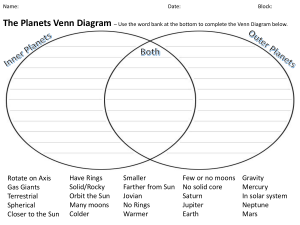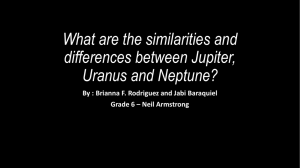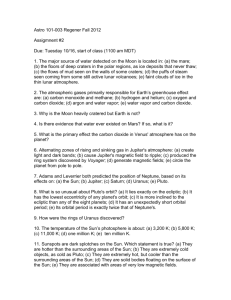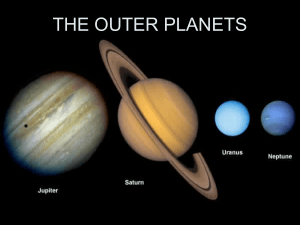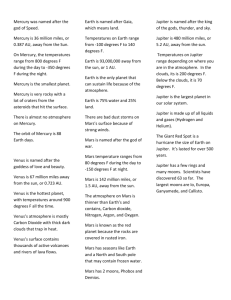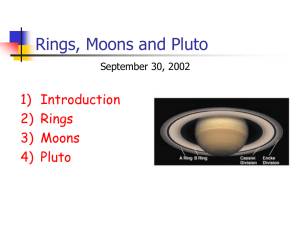Size - Helios
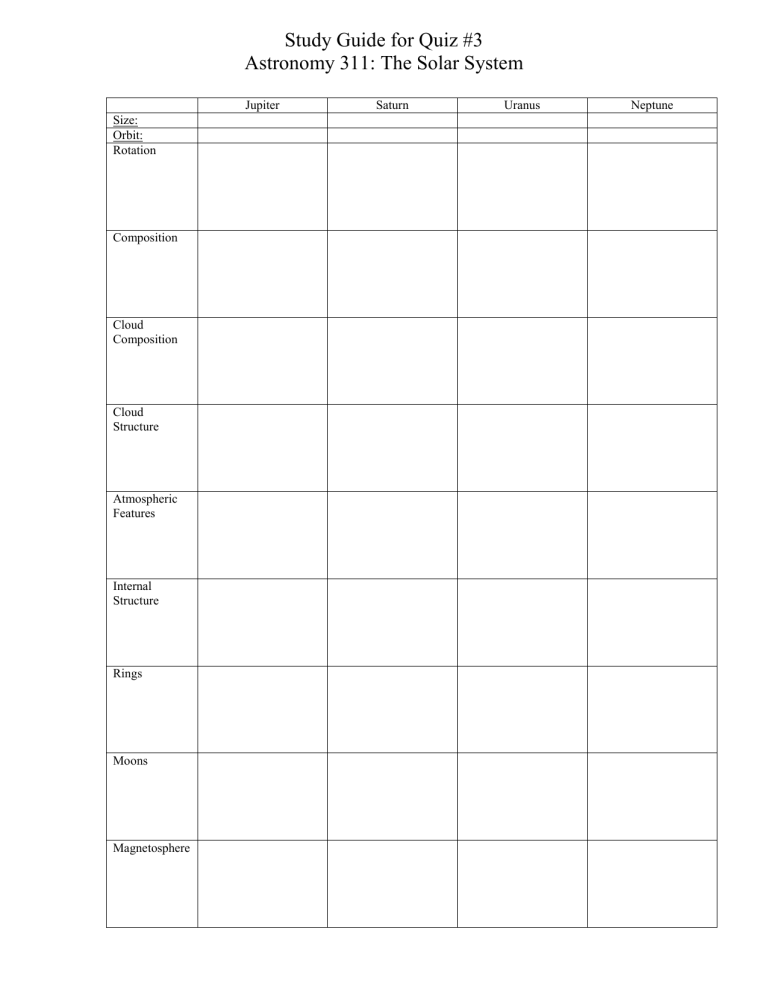
Structure
Atmospheric
Features
Internal
Structure
Rings
Moons
Size:
Orbit:
Rotation
Composition
Cloud
Composition
Cloud
Magnetosphere
Study Guide for Quiz #3
Astronomy 311: The Solar System
Jupiter Saturn Uranus Neptune
Size:
Composition
Surface
Features
Atmosphere
Internal
Structure
Internal Heat
Resurfacing
Orbital
Properties
Temperature
Io Europa Ganymede Callisto Titan Triton Pluto
16: The Gas Giants
Can you define these key words?
Voyager 2
Clouds
Bands
Storms
Oblate
Liquid Metallic Hydrogen
Can you answer these key questions?
What are the key missions to the outer planets?
What important observations were made by Voyager 2?
How does the mass of the gas giants compare to the rest of solar system?
Why do the gas giants have low densities?
What are the key atmospheric features of the gas giants?
What is the basic interior structure of the gas giants?
Can you use these equations and understand what all the variables are?
P
2
= a
3 t = 2(d/a)
½
Can you do the “An Odyssey Through the Solar System Exercise”?
17: Jupiter
Can you define these key words?
Galileo Spacecraft
Shoemaker-Levy 9
Convection
Can you answer these key questions?
How do we learn about Jupiter’s interior?
How does Jupiter produce its magnetosphere?
Can you use these equations and understand what all the variables are?
F = M/D
2
Can you do the “Gravity Exercise”?
18: Saturn
Can you define these key words?
Cassini Spacecraft
Huygens Probe
Roche Limit
Can you answer these key questions?
How (and why) does Saturn’s atmosphere differ from Jupiter’s?
Why does Saturn have more internal heat than we might expect?
What are Saturn’s rings composed of?
Can you describe the structure of Saturn’s rings?
How do moons affect the structure of the rings?
Can you use these equations and understand what all the variables are?
R
Roche
= (4M/
)
⅓
Can you do the “Roche Limit and Rings Exercise”?
19: Uranus and Neptune
Can you define these key words?
Stellar Occultation
Radiation Darkening
Can you answer these key questions?
How was Uranus discovered?
Can you describe the unusual rotation of Uranus?
How were Uranus’s rings discovered?
Why are the rings and moons of Uranus and Neptune so dark?
What is unusual about the magnetic fields of Uranus and Neptune?
How was Neptune discovered?
What is unusual about Neptune’s rings?
How and why do Uranus and Neptune differ from Jupiter and Saturn?
Can you use these equations and understand what all the variables are?
P 2 = (4
/GM)r 3
Can you do the “Finding the Mass of Planets Exercise”?
20: The Moons of the Gas Giants
Can you define these key words?
Tidal Heating
Plasma Torus
Ice Rafts
Can you answer these key questions?
Can you describe and explain the orbits and rotations of the Galilean moons?
How does tidal heating affect the moons of the gas giants?
Where does our information about the gas giant moons come from?
What is the evidence for a liquid water ocean on Europa?
Why does Titan have an atmosphere?
Can you describe Titan’s atmosphere?
Where did Triton come from and what will be its fate?
Can you use these equations and understand what all the variables are?
KE = ½mv 2
PE = mgh g = GM/R 2
Can you do the “Gas Giant Moons Exercise”?
21: Trans-Neptunian Objects and Pluto
Can you define these key words?
New Horizons
Kuiper Belt
Trans-Neptunian Objects (TNO)
Oort Cloud
Classical Kuiper Belt
Resonant Objects
Scattered Disk Objects
Centaurs
Plutinos
Can you answer these key questions?
How was Pluto discovered?
What is the composition and surface properties of Pluto?
How do Pluto’s orbital motions differ from those of the other planets?
What are the properties of Pluto’s moon Charon?
Is Pluto a planet?
How are TNOs found?
What are the main regions where TNOs are found?
How did each TNO region form?
How does gravitational interaction shape the TNO orbits?
Why do we think the Oort cloud exists?
Can you use these equations and understand what all the variables are?
P
2
= a
3 e = c/a
Can you do the “Orbit of Pluto Exercise”?
22: Comets
Can you define these key words?
Edmund Halley
Coma
Dust Tail
Ion Tail
Nucleus
Jets
Meteor Shower
Can you answer these key questions?
What is a comet?
How are comets discovered?
What composes and produces the two tails of a comet?
How are comet orbits altered?
What materials is a comet composed of?
What effects do comet impacts have?
What will be the eventual fate of a comet?
What future space missions will study comets?
23: The Sun
Can you define these key words?
Kelvin-Helmholtz Contractions
Nuclear Fusion
Radiation Energy Transport
Convective Energy Transport
Photosphere
Granules
Sunspots
Chromosphere
Corona
Plasma
Coronal Mass Ejection
Magnetic Activity
Can you answer these key questions?
Why does the Sun shine?
Can you describe the conditions at the Sun’s core?
How does energy get out of the Sun’s core?
Can you describe the Sun’s photosphere?
How and why do the number of sunspots change over time?
What effects does the Sun’s magnetic field have?
Can you describe the Sun’s outer layers?
How are the outer payers of the Sun heated?
Can you use these equations and understand what all the variables are?
E=mc
2
Can you do the “Solar Wind Exercise”?
